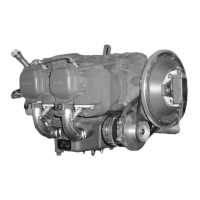SECTION 7 LYCOMING OPERATOR’S MANUAL
INSTALLATION AND STORAGE O-320 SERIES
2. PREPARATION OF CARBURETORS FOR INSTALLATION.
Carburetors that have been prepared for storage should undergo the following procedures before being
placed in service.
Remove the fuel drain plug and drain preservative oil. Remove the fuel inlet strainer assembly and clean
in a hydrocarbon solvent. Reinstall the fuel drain plug and fuel inlet strainer assembly.
3. PREPARATION OF ENGINE FOR STORAGE OR SHIPMENT.
General – The following procedure is intended for application to installed engines, which are being
removed from the aircraft and will provide protection from corrosion for a period of 30 to 60 days.
Preservation Run – Immediately prior to removal of the engine from the aircraft, the engine should be given
a preservation run under the following operating conditions.
Fuel – Normal service fuel.
Oil – Fill sump to normal capacity with preservative type lubricating oil (Soconoy’s Avrex 901, Esso’s
“Rust-Ban 626” or equivalent).
Duration of Run – Operate the engine for a period of four minutes, holding the engine speed to a maximum
of 1800 RPM. All precautions pertaining to ground running should be carefully observed. Cylinder head,
ignition harness, and magneto temperatures should not be allowed to exceed the prescribed limits.
Compound Injection – Upon completion of the preservation run, drain the preservative oil from the engine
and remove, clean and replace the oil suction and oil pressure screens. Perform any of the engine checks,
such as valve clearance or ignition timing, which require rotation of the crankshaft. Disconnect the ignition
harness and remove the spark plugs. Starting with cylinder No. 1, make certain piston is at the bottom of
compression stroke. Fill cylinder with preservative oil (use same oil as specified for preservation run) and
rotate crankshaft until piston is at top center. Oil will spill out of spark plug hole. In order to preserve the
top wall of the cylinder, it will be necessary to either rock the engine, or blow compressed air with very light
pressure into the spark plug hole. Following the engine firing order, preserve the remainder of the cylinders
in the same manner. When all cylinders have been treated, then spray the exhaust port and valve of each
cylinder the piston ¼ turn before top center on the exhaust stroke. When absolutely certain that no further
need exists for turning the crankshaft, again spray each cylinder through the spark plug holes. (Maintain
spray nozzle temperature at 200°F to 220°F (93°C to 104°C) for all spraying operations.)
Installation of Seals and Plugs – Install cylinder dehydrator plugs (Lycoming P/N 40238 or equivalent) in
spark plug holes. Install ignition cable protectors (Lycoming P/N 40239 or equivalent) over the spark
terminal of each ignition cable and secure by attaching to the end of the dehydrator plug. Flush all accessory
drives for which oil seals are provided with preservative oil before assembling the drive covers. Suitable
covers should be used in sealing the exhaust ports; moisture resistant tape (Minnesota Mining and
Manufacturing Company, 711 Acetate Fibre Tape or equivalent) will be sufficient for the ground
connections and similar openings. Install a plug (Lycoming P/N 1540 or equivalent) in the thermometer well
at the rear of the oil pressure screen housing. Install sealing caps (Lycoming P/N 61595 or equivalent) over
the breather opening and (Lycoming P/N 71596 or equivalent) over the generator or alternator blast tube.
Install tachometer drive cap (Lycoming P/N 61545 or equivalent) over tachometer drive. Make sure all other
openings are properly sealed.
7-2

